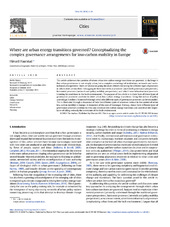Where are urban energy transitions governed? Conceptualizing the complex governance arrangements for low-carbon mobility in Europe
Peer reviewed, Journal article
Published version

Åpne
Permanent lenke
https://hdl.handle.net/1956/15304Utgivelsesdato
2016-05Metadata
Vis full innførselSamlinger
- Department of Geography [634]
Originalversjon
https://doi.org/10.1016/j.cities.2015.10.013Sammendrag
This article addresses the question of where urban low-carbon energy transitions are governed. A challenge is that urban governance is not simply urban, but a complex assemblage of institutions, networks and socio-technical arrangements. There are several on-going literature debates discussing the different types of processes in which cities are involved. I disaggregate these into vertical processes (multilevel governance perspectives), horizontal processes (network and policy mobility perspectives), and what I term infrastructural processes (steering by conditions in the built environment). The purpose of the article is to show how all these types of governance processes combine to drive urban low-carbon energy transitions. Using the notion of policy assemblage, I outline a framework through which the different types of governance processes can be reconciled. This is illustrated through a discussion of how the different types of processes interact in the context of urban low-carbon mobility in Europe. A discussion of the case of Stavanger, Norway, shows how different types of governance processes combine to drive and constrain low-carbon energy transitions and underlines the importance of taking seriously the constraints of the built environment.
